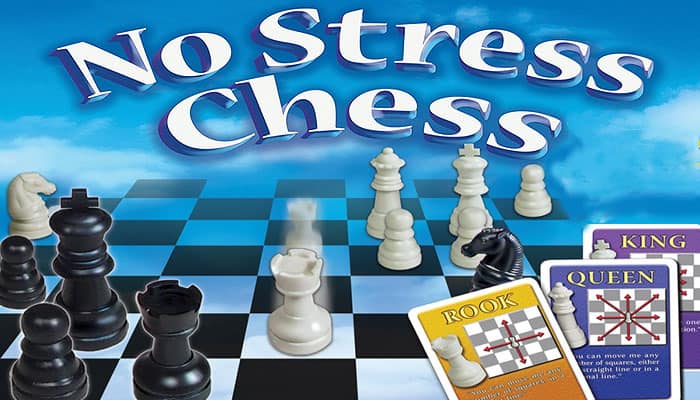

Components
- sets of Standard Chess pieces
- a two-sided Chess board
- a deck of 56 Action cards
- black plastic card tray
- Rulebook
Setup
-

Placing the Pieces. Note: each
player's Queen always begins on
its own colored space.
Place the Chess pieces on the board where indicated.
They are arranged just like in regular Chess, except for two Pawns, which are moved forward as shown on the board left.
These two Pawns are typically moved first by experienced players, in order to clear the way for the more powerful pieces behind them to move.
-
Shuffle the deck of cards thoroughly and place face down in the center compartment of the tray, forming the draw pile.
Game Play - Level One
(Note: each player's Queen always begins on its own colored space)
Players alternate (white first) turning over the top card on the draw pile and placing it face up on their discard pile (compartment of the tray closest to you). Next, move a piece of the type identified and pictured on this card.
The card always explains how you can move this type of piece. Most pieces can be moved one or more spaces along a straight line.

It's up to you to decide when to stop moving along this line. You may never move onto or through a space occupied by one of your pieces. You must always stop moving when you enter a space occupied by an opposing piece, which you then capture and remove from the board (keep it).
You must move if you can (your choice if more than one piece of this type can be moved). If you cannot move a piece shown on the card, you lose your turn. (When the deck is depleted, shuffle both discard piles together to form a new draw pile; play continues).
 Here, the white Queen will be captured if the opposing player draws a Bishop card. But if not, the Queen can capture the Rook if another Queen card is drawn. |
In "No Stress Chess" (unlike Standard Chess) you can take a chance of exposing your pieces to possible capture in the hopes your opponent won't draw a card picturing a piece he can move to capture yours.
This results in some interesting game play, even for experienced Chess players, because it's exciting.
Six cards say "Move Same Type of Piece Again". When you draw one, you move a piece of either type, pictured on the cards on top of the draw piles.
For example, if the card on your opponent's discard pile is a Knight and the top card on your discard pile is a Rook-you can move one of your Rooks, or one of your Knights.
End of the Game
The object of Chess is always to capture the opposing King. In Standard Chess, the opponent "resigns" when this becomes inevitable. In No Stress Chess, a player wins by actually capturing his opponent's King (by moving a piece onto its space).
This makes the King a more useful piece in No Stress Chess as you can risk attacking with it and don't have to spend as much time worrying about it being "checked".

Game Play - Level Two and Three
After you've played Level One a few times, you'll enjoy moving up to Level Two or Level Three.
- In Level Two, deal each player a hand of three cards before play begins.
- In Level Three, deal each player five cards.
Place the remaining deck face down in the draw compartment.
On either level, you begin your turn by drawing a card, then playing any one card from your hand, face up, onto your discard pile and moving a piece of the type pictured (if none of this type can be moved, you lose your turn).
"Move Same Type of Piece Again" cards, when played, are handled as in the Level One rules. Selecting from a limited number of possible moves makes the play of No Stress Chess closer to Standard Chess.
If a player's hand contains three or more identical cards, or a mix of cards which do not allow any piece to be moved, he may discard his entire hand and draw a new one, but may not play on this turn.
Advanced Game
Experienced Chess players like this variation. Play at Level Three, and add the rules for "Pawn Promotion", "En Passant", "Castling", and "Checking" as described in the Standard Rules of Chess below.
In essence, this game follows all the rules of Chess, except that movement is by play of a card instead of by choosing among all of your pieces. (For experienced Chess players, this permits risk taking as found in other games!)
Continue Reading


